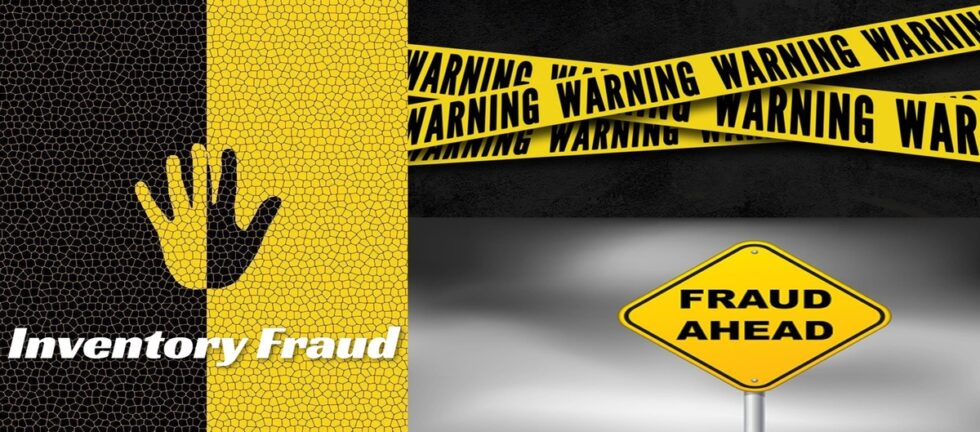Inventory is one of the main targets of fraud. Some companies are more at risk than others for instance retail & manufacturing business are at high risk as inventory is typically the largest value of assets for retail and is huge portion of the asset for manufacturing businesses. However, for service companies with minimal inventory on hand bear little risk of inventory embezzlement.
WHAT IS INVENTORY FRAUD?
Inventory Fraud is one amongst the non-cash fraud schemes. It entails the theft of physical stock items for personal gains and/or the manipulation of a company’s stock records to report a favorable position. The fraud is often perpetrated by employees with access to inventory items in a company, or a corporation itself through manipulation of certain account balances to misrepresent the inventory balance to deceive shareholders, potential investors, and tax authorities.
Inventory fraud could take different forms including under casting the proceeds from the sale of scraps, outright theft, bill-and-hold sales, cut-off schemes, capitalizing costs that should be expensed.
INVENTORY FRAUD EARLY WARNING SIGNS
Companies should continually watch out for inventory fraud early warning signs in their system to be in a safer region in both fraud cases either business is the victim where inventory is being stolen or the financial statements are being manipulated for some reason, there are several warning signs that indicate that there may be a problem.
- Dramatic changes to the inventory turnover ratios
- Inventory rising faster than total assets.
- Inventory values are increasing at a faster rate than sales
- Low inventory valuation even though the warehouse is full of inventory
- High inventory valuation even when the warehouse is empty
- The inventory asset value does not change for several periods, or the change is minimal
- The gross profit percentage never changes from period to period
- Falling cost of sales as percentage of sales.
- Shipping costs as a percentage of inventory changing dramatically
- Shipping invoices that cannot be traced to purchases or sales
- Shipping invoices with strange or unauthorized delivery addresses
TWO TYPES OF INVENTORY FRAUD:
There are essentially two types of inventory fraud: actual physical loss and financial statement fraud.
1. EMPLOYEE THEFT
Theft by employees results in an actual loss of inventory. This is rather common in a retail setting, in which an employee steals business inventory for personal use, such as consumer goods that are small and easy to hide. Some employees also steal inventory for resale, which can happen any number of ways, from receiving clerks to night-crew stockers.
WARNING SIGNS THAT EMPLOYEES MAY BE STEALING INVENTORY
-
-
- Missing documents (packing slips, shipping receipts, etc.)
- Employees living above their means
- Complaints by employees or customers that personal effects are being lost or stolen
- Unhappy employees who feel they deserve more in either salary or benefits
- Employees who refuse to go on vacation for fear of their substitute catching the theft
- Frequent shortcuts in security procedures in order to hasten deliveries
- Bringing baggage to/from work
- Signing another employee’s name or signing illegibly on inventory documents
- Frequent cash shortages or overages on the same employee’s shift
- Unusually high number of “no sale” transactions
-
2. FINANCIAL FRAUD- INVENTORY MANIPULATION
Inventory fraud can be committed through financial statement manipulation. This includes timing schemes, expenses recorded as inventory, and valuation schemes. This type of fraud is usually implemented by senior management and is motivated by the need to attain some financial goal or benchmark.
Inventory overstatement is the most common type of inventory related fraud. Management may be motivated to report high earnings to either satisfy stockholders, achieve compensation targets, or maintain bank lending covenants.
One way to inflate income is to overstate inventory. This was the type of fraud in some of the most famous and significant public company frauds in recent history. Cost of Goods sold is calculated by subtracting the increase in inventory from purchases. Therefore, overstating ending inventory (increase in inventory) understates cost of goods sold and has the effect of reporting higher profit.
Alternatively, management is sometimes motivated to report lower profit in order to limit the amount of taxes. This is particularly prevalent in small closely held businesses. In this case, understating inventory accomplishes the overstatement of cost of goods sold and, as a result, net income.
STRATEGIES FOR INVENTORY FRAUD PREVENTIONS
Companies exposed to inventory fraud could take the subsequent fraud preventive measures
-
Monitor Inventory Metrics
If your year-end inventory counts are not adding up, do not just write off the discrepancy investigate the reason compute various inventory ratios, including:
-
- Days in inventory (average inventory divided by annual cost of sales times 365 days)
- Gross margin (sales minus cost of sales) as a percentage of sales
- Inventory as a percentage of total assets
- Returns as a percentage of annual sales
- Shipping costs as a percentage of sales
These metrics should be consistent over time and comparable to industry benchmarks. Sudden changes require immediate action.
-
- Write-offs for obsolescent or spoiled goods should be examined for validity.
- Financial statements can be analyzed to compare prior and current periods and to review changes in inventory ratios over time. Industry norms can be compared to your company’s figures. Variances from expectations should be investigated and explained
-
By Segregation of Duties:
Businesses entrust a lot of responsibilities to a person they trust. This move can lead to inefficiency and possibly fraud. Since one person has numerous duties, he can easily get away with shady practices and inventory theft. Segregation of duties also assures that one employee’s actions are verified and approved by another. One employee may retrieve the stock for processing, while another counts the inventory and updates the records. It’s difficult for either one of them to steal inventory unless the two employees are scheming together.
-
Regular Production Yield Analysis:
Data analysis goes a long way in detecting fraud. The difference between expected output and actual output is called production yield. Given the number of raw materials, labor, and time taken, you can find out how much the resulting output is. If the difference between expected and actual output is too much, someone might be committing inventory fraud in your company. Data is your biggest weapon in the fight to tackle inventory fraud.
-
Surprise Inventory Counts:
Many companies make the mistake of scheduling their checks, and they conduct checks in a pattern. Employees who have been at the company can figure out the pattern and work their fraud around it. A regular surprise inventory count could function as a superb fraud deterrent. If inventory counts are not adding up, it is advisable not to just write off any difference between the count’s result and the physical inventory to cost of sales by rather investigating the root cause and taking proper corrective actions.
-
Automate Inventory Record Keeping:
Automating inventory and reporting is the best way for business owners to prevent inaccurate inventory records, malicious dishonesty, and theft. For this, comprehensive inventory management systems are available. Such software can track the progress of inventory stocks, from the time it is acquired to when it moves into finished goods inventory. The system provides real-time and complete updates on inventory status and possible red flags.
-
Installation of CCTV:
Any lack of physical security that contributes to the theft of inventory, by both employees and non-employees is considered an area of weakness. If items are available to any employee without prior authorization or requisition, inventory will be vulnerable to theft. Installation of CCTV to increase vigilance around the entity to deter persons with intention of theft.
-
Fraud Management System:
Establishing a strong fraud management system that would facilitate prevention and early detection of inventory fraud and misstatements of inventory balance.
-
Corporate Culture:
A positive work environment will prevent fraud. There should be a clear organizational structure, written policies and procedures and fair employment practices. An open-door policy can also provide a great fraud prevention system as it gives employees a positive open line of communication with management. Business owners and senior management should lead by example and hold every employee accountable for their actions.
CATCH FRAUD EARLY
Many businesses are unaware that inventory balances are inaccurate until they have accrued substantial losses. Organizations should ensure fraud early warning signs are regularly monitored and investigated whenever these signs are evident within the system.
Inventory fraud deterrent mechanisms should be established in prone organizations and, where necessary, perform a regular system assessment and inventory audit.

Alia Noor (FCMA, CIMA, MBA, GCC VAT Comp Dip, Oxford fintech programme, COSO Framework)
Associate Partner
Ahmad Alagbari Chartered Accountants






